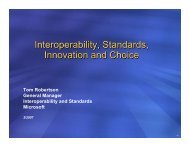NATO Standardization Agency - The Bolin Group
NATO Standardization Agency - The Bolin Group
NATO Standardization Agency - The Bolin Group
You also want an ePaper? Increase the reach of your titles
YUMPU automatically turns print PDFs into web optimized ePapers that Google loves.
<strong>NATO</strong><br />
<strong>Standardization</strong> <strong>Agency</strong><br />
Interoperability and <strong>Standardization</strong><br />
within<br />
<strong>NATO</strong><br />
Vice admiral Juan A. Moreno<br />
Director, NSA<br />
Director’s office<br />
1
New Environment<br />
• New Threats<br />
• Article 5 / Non-Article 5<br />
• New Forms of Conflict<br />
• New Security-Political Actors<br />
• New Tasks and Operations<br />
• Increased Speed of Technical Innovation<br />
• Ongoing Transformation<br />
Director’s office<br />
2
New Threats<br />
• Multiple, suicide attacks<br />
against soft civilian targets --<br />
maximum casualties<br />
• Increased chance of terrorist act<br />
involving chemical, biological,<br />
radiological or nuclear weapons<br />
• Nationalistic Demands<br />
Director’s office<br />
3<br />
3
Article 5<br />
Defined Region with National<br />
Forces in their designated<br />
Areas of Responsibility<br />
Relatively lower challenges<br />
<strong>NATO</strong> only<br />
for Interoperability<br />
High Intensity Warfare<br />
and <strong>Standardization</strong><br />
Concentration of (Heavy) Forces<br />
Army Corps as National Entities<br />
Director’s office<br />
4
Non-Article 5<br />
<strong>NATO</strong> in lead with Participants<br />
from PfP and other Nations<br />
Global, but size of Area of<br />
Operations is limited<br />
Considerably higher<br />
challenges for<br />
Range from Humanitarian Aid to Combat Ops<br />
Troops dispersed and “light”<br />
Interoperability and<br />
Multinational Mix down to Unit Level<br />
<strong>Standardization</strong><br />
Director’s office<br />
5
<strong>NATO</strong> Interoperability<br />
Interoperability is:<br />
“Is the ability to operate in synergy<br />
in the execution of assigned tasks”<br />
Director’s office<br />
6
Cold War<br />
Air<br />
Interoperability<br />
Navy<br />
Land<br />
Mission<br />
Director’s office<br />
7
Partnership for Peace (PfP)<br />
Air<br />
Navy<br />
Interoperability<br />
Land<br />
Mission<br />
Director’s office<br />
8
Now<br />
Air<br />
Navy<br />
Interoperability<br />
Land<br />
Mission<br />
Director’s office<br />
9
NO CAPABILITY<br />
WITHOUT<br />
INTEROPERABILITY<br />
Director’s office<br />
10
<strong>NATO</strong> Policy for <strong>Standardization</strong><br />
<strong>NATO</strong> <strong>Standardization</strong> is defined as:<br />
“<strong>The</strong> development and implementation<br />
of concepts, doctrines, procedures, and designs<br />
to achieve and maintain<br />
the required levels of<br />
compatibility, interchangeability or commonality<br />
in the<br />
operational, procedural, material, technical and<br />
administrative fields<br />
to attain<br />
INTEROPERABILITY.”<br />
Director’s office<br />
11
Levels of <strong>Standardization</strong><br />
Compatibility:<br />
“<strong>The</strong> suitability of products, processes or services for<br />
use together under specific conditions to fulfil relevant<br />
requirements without causing unacceptable<br />
interactions.”<br />
Interchangeability:<br />
“<strong>The</strong> ability of one product, process or service to be<br />
used in place of another to fulfil the same<br />
requirements.”<br />
Commonality:<br />
“<strong>The</strong> state achieved when the same doctrine,<br />
procedure or equipment are used.<br />
Director’s office<br />
12
<strong>NATO</strong> <strong>Standardization</strong><br />
Aim of <strong>NATO</strong> <strong>Standardization</strong><br />
Enhance operational effectiveness through<br />
Interoperability<br />
among Alliance forces, and between <strong>NATO</strong> forces<br />
and forces<br />
of Partners and other nations<br />
Director’s office<br />
13
<strong>Standardization</strong> in <strong>NATO</strong><br />
Mission of the<br />
<strong>NATO</strong> <strong>Standardization</strong> Organization (NSO)<br />
Is to harmonize and coordinate Alliance <strong>Standardization</strong><br />
efforts with the aim of enhancing Interoperability and<br />
enable Alliance Forces to train, exercise and operate<br />
effectively together, and when appropriate, with Forces of<br />
Partners and other nations, in the execution of assigned<br />
missions and tasks.<br />
Director’s office<br />
14
<strong>Standardization</strong> in <strong>NATO</strong><br />
TA’s<br />
NAC<br />
NSO<br />
SCEPC<br />
SNLC<br />
NPC<br />
NADC<br />
support<br />
MC<br />
NCS<br />
NCSREPS<br />
report<br />
CNAD<br />
NC3B<br />
NSA<br />
chair<br />
Civil Operational<br />
Materiel / C 3<br />
NSSG<br />
<strong>NATO</strong> <strong>Standardization</strong><br />
Staff <strong>Group</strong><br />
SCs<br />
Director’s office<br />
15
<strong>The</strong> <strong>NATO</strong> <strong>Standardization</strong> <strong>Agency</strong><br />
Mission<br />
Initiates, coordinates, supports and<br />
administers<br />
• <strong>Standardization</strong> and Interoperability policy for the<br />
Alliance under the authority of the <strong>NATO</strong> Committee<br />
for <strong>Standardization</strong><br />
• Operational <strong>Standardization</strong> and Terminology under<br />
the authority of the Military Committee<br />
• Acts as the focal point of liaison with civil<br />
<strong>Standardization</strong> Organizations<br />
Director’s office<br />
16
<strong>The</strong> <strong>NATO</strong> <strong>Standardization</strong> <strong>Agency</strong><br />
Director<br />
Director NSA<br />
PE: 49 Posts (28 mil / 19 Civ)<br />
Front Office<br />
(MA/PA)<br />
Admin &<br />
Support<br />
Branch<br />
Policy &<br />
Coord<br />
Branch<br />
Joint<br />
Branch<br />
Army<br />
Branch<br />
?<br />
Naval<br />
Branch<br />
Air<br />
Branch<br />
Policy<br />
Programmes<br />
Terminology<br />
Partner Programmes<br />
Civil Standards<br />
Supporting<br />
MC TC<br />
Supporting<br />
MCJSB,<br />
MCMEDSB,<br />
11 WGs,<br />
18 Panels<br />
Supporting<br />
MCLSB,<br />
9 WGs,<br />
35 Panels<br />
Supporting<br />
MCMSB,<br />
9 WGs,<br />
16 Panels<br />
Supporting<br />
MCASB,<br />
4 WGs,<br />
19 Panels<br />
Director’s office<br />
17
What is a<br />
STANAG and an AP ?<br />
<strong>NATO</strong> STANDARDIZATION AGREEMENT (STANAGs)<br />
“<strong>The</strong> record of an agreement among several or all<br />
member nations to adopt like or similar military<br />
equipment, ammunition, supplies, stores as well as<br />
operational, logistic and administrative procedures”.<br />
ALLIED PUBLICATION (APs)<br />
“An AP is an official <strong>NATO</strong> standardization<br />
document which some or all <strong>NATO</strong> nations agree<br />
to use as a common implementing document and<br />
which is distributed down to user level”.<br />
Director’s office<br />
18
Top-Down / Bottom-up<br />
<strong>Standardization</strong><br />
Top-Down<br />
• initiated when the Strategic<br />
Commands identify Military<br />
<strong>Standardization</strong> Requirements<br />
(MSR)<br />
• part of the Force Proposals for<br />
nations participating in the Force<br />
Planning Process<br />
.<br />
⇒ longer and slower<br />
Bottom-Up<br />
•initiated by reporting standardization<br />
needs and/or deficiencies by Nations<br />
or <strong>NATO</strong> commands<br />
• followed by <strong>Standardization</strong><br />
Proposals (SPs), formulated by <strong>NATO</strong><br />
Working <strong>Group</strong>s,<br />
• validated by the appropriate Authority<br />
who has to confirm the SP before the<br />
development of STANAG/AP starts.<br />
⇒ react in short time to<br />
shortfalls/ interoperability<br />
gaps<br />
Director’s office<br />
19
Integration through Interoperability<br />
PURPOSE<br />
INTEGRATION<br />
CAPABILITY<br />
ORIENTATION<br />
JOINTNESS<br />
AIM<br />
INTEROPERABILITY<br />
STANAGs<br />
APs<br />
MEANS<br />
Materiel<br />
STANDARDIZATION<br />
Operational<br />
Administrative<br />
COMMONALITY<br />
INTERCHANGEABILITY<br />
COMPATIBILITY<br />
Director’s office<br />
20
Remarks<br />
• Contribution to the Comprehensive Political<br />
Guidance (CPG)<br />
• <strong>NATO</strong> Interoperability Process<br />
• Development of <strong>NATO</strong> Standards within<br />
substructure (Meetings, Working <strong>Group</strong>s)<br />
consisting of subject matter Experts of Nations<br />
• Use of civilian Standards whenever possible<br />
• Close cooperation with other standardization<br />
bodies (NAMSA, MSHT, …)<br />
• Voluntary to nations<br />
• Use of <strong>NATO</strong> agreed Terminology<br />
Director’s office<br />
21
Director’s office<br />
22









